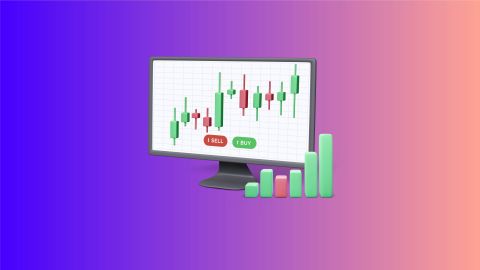Key elements of the fear & greed index
The Fear and Greed Index uses two types of metrics to evaluate overall market sentiment. One of these is price-based metrics, which assess investor behaviour through technical market indicators. These include:
- Price momentum
This measures the rate at which stock prices rise or fall over time. Strong upward momentum typically signals bullish sentiment, while weakening momentum may reflect increasing fear among investors.
- Number of stocks hitting 52-week highs vs. lows
A higher number of stocks reaching 52-week highs suggests investor confidence and greed, while more stocks hitting 52-week lows indicates market pessimism and heightened fear levels.
- Proportion of stocks advancing vs. declining
This compares the number of stocks gaining in value to those declining. A greater proportion of advancers reflects positive sentiment, while more decliners point to negative market outlooks.
- Put and call options volume
This metric analyses the trading volume of put (bearish) versus call (bullish) options. A high put volume shows fear-driven hedging, whereas more calls indicate rising investor confidence and greed.
- Market volatility
Volatility gauges the degree of price fluctuations. High volatility typically accompanies fear and uncertainty, while lower volatility reflects a stable, confident market often associated with greed.
7 fear & greed indicators
The Fear & Greed Index is calculated using seven distinct indicators, each highlighting different aspects of market behaviour:
1. Stock price momentum
- Measures the pace of stock price trends.
- Rapid upward movements suggest greed, while declining trends indicate fear.
2. Stock price strength
- Compares the number of stocks hitting new highs versus those reaching new lows.
- A greater proportion of new highs signals bullish sentiment (greed), whereas more new lows reflect bearish sentiment (fear).
3. Market volatility
- Evaluates fluctuations in the market, often using the Volatility Index (VIX).
- High volatility reflects fear, while lower volatility suggests a stable market driven by greed.
4. Junk bond demand
- Analyses interest in high-yield bonds, which carry higher risks.
- Strong demand for these bonds signals confidence (greed), whereas reduced demand highlights caution (fear).
5. Put and call options
- Tracks the ratio of bearish put options to bullish call options.
- A high ratio of puts to calls indicates fear, while a dominance of calls over puts suggests greed.
6. Safe haven demand
- Measures the appeal of low-risk assets like gold and government bonds.
- Increased demand for these assets signifies fear, while lower interest reflects a preference for riskier investments (greed).
7. Market momentum
- Compares current market performance against historical averages.
- Outperforming the average indicates greed, while underperformance signals fear.
How does the fear and greed index work?
The fear greed index is a valuable tool for investors seeking insights into market sentiment and potential trends. In the context of the Indian stock market, understanding how this index works can help traders make more informed decisions.
1. Component indicators
The fear and greed index combines various indicators to gauge market sentiment accurately. These indicators typically include factors such as:
- Stock price momentum: Measures the speed at which stock prices are moving.
- Stock price strength: Assesses the number of stocks hitting 52-week highs versus lows.
- Put and call options: Examines the ratio of put options (bearish bets) to call options (bullish bets).
These components collectively provide a comprehensive overview of investor sentiment in the Indian stock market.
2. Calculation
The fear and greed indicator is calculated based on a scale ranging from 0 to 100. Extreme fear is represented by a score of 0, while extreme greed corresponds to a score of 100. The index is derived from the weighted average of the individual indicators.
3. Interpretation of scores
- Extreme fear (0-20): Indicates that investors are overwhelmingly pessimistic, possibly leading to undervalued stocks. Contrarian investors may see this as a buying opportunity.
- Fear (21-40): Suggests a cautious market sentiment with potential opportunities for bargain hunting.
- Neutral (41-60): Signifies a balanced market sentiment without a strong bias towards fear or greed.
- Greed (61-80): Shows that investors are becoming more optimistic, and caution may be warranted as the market might be overbought.
- Extreme greed (81-100): Reflects a high level of optimism, often signalling a potential market correction as euphoria sets in.
4. Contrarian investing
This indicator is particularly useful for contrarian investors who go against the prevailing market sentiment. For instance, if the index indicates extreme fear, contrarian investors might consider buying as the market may be oversold. Conversely, extreme greed could be a signal to sell or exercise caution.
5. Market trends and risk evaluation
Investors can use the fear and greed index to identify potential trends in the Indian stock market. Additionally, it helps in evaluating the overall risk appetite, allowing investors to adjust their strategies accordingly.
6. Monitoring changes
The fear and greed index is not a static metric; it evolves as market sentiment changes. Regular monitoring of the index can provide valuable insights into shifts in investor sentiment, enabling proactive decision-making.
Advantages of Fear and Greed Index
Here are some noteworthy advantages to consider
1. Quick market sentiment assessment
The fear and greed index provides a rapid and condensed snapshot of market sentiment. Investors can swiftly gauge whether the prevailing mood is one of fear, greed, or neutrality, aiding in timely decision-making.
2. Trend identification
The fear and greed index helps investors identify potential trends in the market. By recognising shifts in sentiment, investors can adapt their strategies to align with or counter prevailing trends.
3. Risk management
Understanding the fear and greed dynamics allows investors to better manage risk. Extreme levels can be indicative of potential market reversals, prompting investors to adjust their portfolios to mitigate risks associated with overbought or oversold conditions.
4. Comprehensive overview
By incorporating multiple indicators, the index offers a holistic view of market sentiment. This comprehensive approach provides a more nuanced understanding than relying on individual metrics, enhancing the quality of decision-making.
Disadvantages of Fear and Greed Index
Here are a few drawbacks associated with fear and greed indicator
1. Overreliance on sentiment
Depending solely on sentiment indicators like the fear and greed index may lead to overreliance on emotional factors, neglecting fundamental analysis. Market sentiment can be fickle, and decisions based solely on sentiment may not always align with underlying market realities.
2. Subjectivity and interpretation
The interpretation of fear and greed is subjective, and different investors may perceive the same index value differently. This subjectivity can lead to varied investment strategies and decisions based on individual interpretations of market sentiment.
3. Limited predictive power
The fear and greed indicator, like any other sentiment indicator, has limitations in predicting future market movements. While it can offer insights into the current emotional state of the market, it does not guarantee accurate forecasts of future price actions.
4. Dynamic nature of markets
Markets are dynamic and can change rapidly. The fear and greed index provides a snapshot at a particular moment, but sentiment can shift quickly. Investors must be cautious about making long-term decisions solely based on short-term sentiment readings.
Conclusion
Incorporating the fear and greed index into investment strategies can be beneficial, provided investors are aware of its advantages and limitations. While it offers valuable insights into market sentiment and contrarian opportunities, it should be used with other analytical tools for a more well-rounded investment approach. Investors must strike a balance between acknowledging market emotions and maintaining a disciplined, diversified, and informed investment strategy to navigate the complexities of the stock market.
Additional topics for you to read





